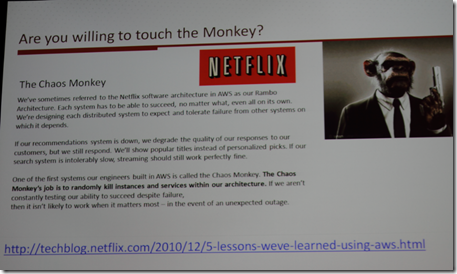Mike Manos gave a keynote at Uptime Institute in his new role at AOL as VP of Technology, and was back with his entertaining presentation style. Mike's talk was on "Preparing for the Cloud: A Data Center Survival Guide", but Mike wisely changed his presentation to challenge the attendees to stop being Donkeys.
Watch this video where Mike makes the point too many people behave like a donkey, like Eeyore and they are depressed about the coming of the Cloud.
Eeyore is generally characterized as a pessimistic, gloomy,depressed, anhedonic
Mike Manos Don't be Donkeys
Here is background on why Mike is calling out the Donkey analogy and how he was inspired for this talk.. at 3:45 mark is where the Donkey/Eeyore idea is mentioned.
Mike Manos Listening to the Uptime Audience
Mike challenges the tag line "disrupted data center" as most of what is being discussed this week was discussed last year and the year before.
Mike Manos disrupted data center
Mike uses Netflix's Chaos Monkey as a response to being a donkey.
The best way to avoid failure is to fail constantly.
We’ve sometimes referred to the Netflix software architecture in AWS as our Rambo Architecture. Each system has to be able to succeed, no matter what, even all on its own. We’re designing each distributed system to expect and tolerate failure from other systems on which it depends.
If our recommendations system is down, we degrade the quality of our responses to our customers, but we still respond. We’ll show popular titles instead of personalized picks. If our search system is intolerably slow, streaming should still work perfectly fine.
One of the first systems our engineers built in AWS is called the Chaos Monkey. The Chaos Monkey’s job is to randomly kill instances and services within our architecture. If we aren’t constantly testing our ability to succeed despite failure, then it isn’t likely to work when it matters most – in the event of an unexpected outage.

Are you a Donkey or Chaos Monkey?

Mike and I had a chance to talk about the reaction of people to his talk. He had tons of people come up and say how they loved his talk. Mike figured he had 50 people confess they were donkeys. The funny thing is the guys I were hanging out during Mike's talk admitted they are chaos monkeys.
Why are Donkeys so bad? Because they slow down the movement of a group. Consider this article on how groups disrupt crowd flow.
Secret of Annoying Crowds Revealed
by Dave Mosher on 7 April 2010, 5:00 PM
Get in line! People self-organize in crowds, often without thinking about it.
Push, shout, or politely excuse yourself all you want, but those slowpokes in your way just won't budge. A new study shows a long-neglected reason why: Up to 70% of people in crowds socially glue themselves into groups of two or more, slowing down traffic. What's worse, as crowds gets denser, groups bend into anti-aerodynamic shapes that exacerbate the problem. The study may be a boon to urban planners.
It is interesting to think of movement of ideas in the data center space like a crowds of people moving.

Uptime's Pitt Turner quickly adjusted his follow on to Mike Manos's call to action by telling people to take action and stop being donkeys. But, telling people to move faster in a crowd can do more harm than good.
The study also determined that those who ask others to move faster actually do more harm than good. “You're contributing to chaos. Crowds are self-organized systems, so when you don't cooperate, the system breaks and you slow everyone down,” Moussaid concludes.
It was great to see Mike back in action and catch up. I told Mike he should try and focus a presentation on the question of are you a Donkey or a Chaos Monkey? It is a great topic that gets people thinking.
I think of my readers as more in the Chaos Monkey crowd. I hope you do too. I know I have too much fun creating making trouble. I want one of the AWS Chaos Monkey T-shirts.
THINKING MAN Daniel Kahneman outside his Berkeley, California, home. “He [is] more alert and alive than most 20-year-olds,” writes Lewis.





